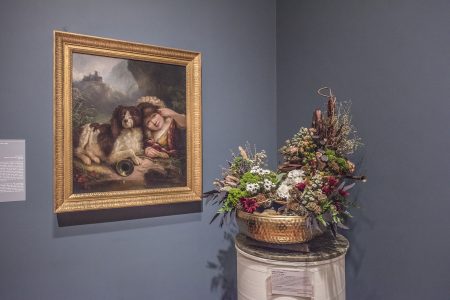By its nature, Art in Bloom at the Cincinnati Art Museum comes and goes quickly in its biennial appearances. This year’s took place October 17 – 20 and as usual brightened the experience of Museum-goers on those fortunate days. If visual art is sometimes considered a for-the-ages sort of thing, blooming flowers are its exact opposite but in their brief life can establish pleasant and fruitful relationships with art of all sorts despite diversity of ages and backgrounds.
“Interacting with the art is key,” co-chair of this year’s event Marilyn Duke told me. She and her co-chair, Sarah Stahl, shared responsibility for this year’s appearance of Art in Bloom. “The exhibition has been a developing thing since its first appearance in 2001. This year’s event is the tenth,” Duke said. Although other museums stage similar exhibitions, CAM is unique in choosing a fall date. Spring is the usual choice elsewhere. Anyone interested – not just Art Museum members – may take part. An interesting mixture of professional and amateur work results, with it hard to draw a line between one and the other.
This year’s version took on “Light” as its theme but a theme was hardly needed as floral arrangements can interact with art objects like cousins once removed – visual pleasures are an object of each. Of interest to me was the mixture of amateur and professional work and their easy juxtaposition. Local garden clubs, professional designers, groups and individuals all took part, responding to selected paintings, ceramics and sculptures in the Museum’s collection. The exhibition was organized by a committee of nearly twenty people, including the co-chairs, who worked with Museum staff in carrying out this extensive project. One of its benefits: it attracts viewers and participants from a diversity of age.
The visitor first encountered art plus nature in the long hall directly beyond the museum’s entrance, where the Steinberg mural (pretty sprightly looking on its own) was further enlivened by three tall bouquets placed at intervals along its length. The arrangements themselves, as would be true throughout the displays, were designed to pick up colors and shapes from the art they accompanied. One example: a Rookwood chimney piece from 1903, its border suggesting fruit shapes, was accompanied by flowers echoing both the shapes and colors.
Jill Dunne, the Art Museum’s director of marketing and communications,was out of town when I looked at the show, but asked by email what had been different in this year’s presentation of the exhibition replied “It was the first time we brought in a penguin for programming. It was an African penguin and it created an art work in the courtyard. Thane Maynard of the Cincinnati Zoo and Botanical Garden led a discussion on it.” How many art museums have turned to penguins to enliven programming?
Marilyn Duke was proud of the extent to which the exhibition attracts active participants. “It’s an umbrella for all achievers,” she said. “We brought in first time flower arrangers and provided training at workshops in March and in June and July. It also provides an umbrella for special events.” The program is, she feels, “a 21sst century kind of project. An umbrella for all achievers.” Other cities that have similar recurrent exhibitions linking art and plant life are Chattanooga, Boston, New Orleans, Huston.
This is clearly a crowd-pleaser of a show. Tours are booked months in advance, enthusiasm is high among participants. “It’s like hitting a home run,” someone told me. Why not? Visual art very likely has deeper philosophic roots than baseball, but who’s to say?





